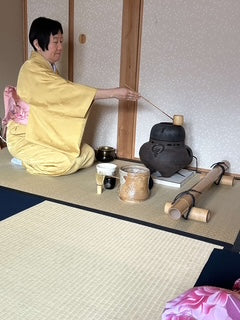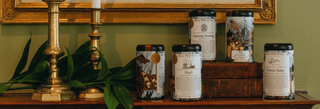Dear Oliver,
For tea lovers, no trip to Japan would be complete without attending a formal ceremonial tea. For visitors, the traditional four-hour experience is often abbreviated, but it still offers a glimpse into the very detail-oriented, reverential sharing of tea.
The one I recently tried in Kyoto, Japan featured donning the full formal attire prior to the ceremony. Arriving one hour prior to our tea time, we were directed to first put on cotton underclothes. Then, a team of expert ladies tightly wrapped us in layers of cloth before we finally put on the pretty flowered kimonos we had chosen. After that, they added the wide, contrasting fabric belt that was tied with a huge bow in the back. In addition, our hair was swept up and flowers added to complete the look.
We were given split toe socks and wooden sandals and sent out into the town. After a few photo opportunities and some souvenir shopping, our tea time arrived.
Depositing our sandals at the door, we entered the tea shop. We were escorted to a special room with woven mats on the floor and sliding doors with opaque paper panels. The hostess had prepped the room with a traditional tea scroll hanging on the wall and special flowers. She also had a special silk towel she would soon use to dry several items. We were given a fan that we set down in front of our places to denote our physical boundaries. We also had small napkins and a special combination knife/fork for our sweet snack during tea.
While we were seated, we watched our hostess perform the ritual of purifying the utensils, which is done before and after the ceremony. The water must stay between 80-90 degrees for this step and this temperature is said to make the best ceremonial matcha. We learned that both “thin” and “thick” tea can be created by adding more or less water, which seems logical, but just how thick was new to us. Our tea was the “thick” variety and a very small amount of water was used with less than a teaspoon of matcha powder, leaving only a few sips in our bowls.
Our ceremony included instructions on how to perfectly whisk the matcha to create a nice green foam in our tea bowls using a special bamboo whisk. After we consumed our tiny amount of thick matcha tea, we were then given a sample of a “main” wagashi sweet, which was a delicious mochi. Often, after more tea is consumed, a
second “hard” sweet follows.
Thankfully, Oliver, you offer Matcha and readers can order the delicious powdered tea for their own ceremonies. As you describe on your website, “Eisai, (1141-1215) a Japanese Buddhist Monk, spent the better part of his life studying Buddhism in China. In 1191, Eisai returned permanently to Japan, bringing with him tea seeds along with the Zen Budddhist methods of preparing powdered green tea. The Seeds that Eisai brought back with him from China were largely considered to create the highest quality tea leaves in all of Japan. Eisai also brought back the tradition of the tea ceremony.”
Enjoying the delicious ceremonial matcha was truly a special experience. It piqued my interest about the powdered green tea and I will send more information about matcha the next time I write. Sayonara.





